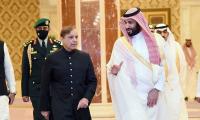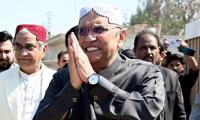Over the years, Pakistan’s currency has continued to decline unabatedly. However, the 30 percent reduction in rupee value during the last 10 months has been unprecedented and arguably unwarranted. On June 27, the dollar hit an all-time high: 164 against the Pakistani rupee.
Regrettably, people are not even aware of the mechanism adapted to ascertain the real value of the rupee. There is always confusion over the issue, deliberate or otherwise. At times, the government claims to have no control over the rupee’s value and mysterious market forces are blamed for the free fall. Occasionally, we as citizens are informed that the rupee is being devalued in the best interest of Pakistan since a devalued rupee will boost Pakistan’s exports. Interestingly, the day the rupee suddenly crossed 143 against a dollar, the incumbent prime minister claimed to have learnt about it through the media.
Despite massive devaluation recently, the export growth is negligible. The mantra of ‘enhancing exports through lowering the rupee’ is not new to Pakistan. Similar rhetoric was deployed in the past. But devaluation never translated into economic growth. There is no evidence over the last seven decades that suggests a rise in exports as a result of lowering rupee price in Pakistan. The question is: can the Pakistani rupee afford a downslide?
The apparent answer to the above question is simply no for a number of plausible reasons. The first and foremost argument is: a developing country like Pakistan which is already under massive international debt ($97 billion) cannot even think of lowering its currency value. There is no rocket science to understand this phenomenon. A 30 percent reduction in rupee value simply means a 30 percent increase in Pakistan’s debt. Ultimately, Pakistan has to translate the rupees into dollars since it is not producing dollars.
Second, the reduction in currency value has led to a higher degree of inflation which is now beyond anyone’s control. The increase in energy prices has in turn escalated the prices of all consumer goods to an unaffordable level. The reduction in currency value during the last one year has in other words decreased the purchasing power of an average Pakistani by 40 percent. Those folks from lower-income groups are the major victims of the recent inflation and sky rocketing prices.
Third, unlike China, Pakistan can never imagine to keep the currency undervalued. Pakistan just cannot emulate the Chinese model for the reason that China is an export-led economy with global outreach. On the contrary, Pakistan is an inward looking, fragile and import-based economy. It is heavily dependent on foreign loans. Furthermore, China has dollars in its kitty whereby Pakistan is begging for dollars to keep its reserves going.
Fourth, as amply highlighted, Pakistan’s economy is import driven. There is already a huge gap between our exports and imports. During 2018, Pakistan’s imports touched $60 billion whereas exports during the same period could only cross $23 billion. Hence, the overall trade deficit was around $27 billion. The import bill is likely to go further up as a natural consequence of currency devaluation. The import bill of oil has already gone up by 6.7 percent during the first eight months of FY 2018-19, according to the Pakistan Bureau of Statistics (PBS). The oil imports worth $3 billion per year for the next three years on deferred payment agreed by Saudi Arabia and similar arrangements promised by the UAE may provide some short-term relief but may not work in the long run. You cannot run a country the way you run a charity.
Fifth, the higher inflation and continuous currency devaluation has resulted in the nuisance of higher discount rates by the State Bank of Pakistan (SBP). The present discount rate stands at 12.25 percent, which means that commercial banks will lend money close to 15 percent. At these interest rates, anyone interested in doing business in Pakistan is discouraged. Similarly, the government of Pakistan by default increased its expenditures as it usually borrows from commercial banks.
Having visualized the impact of the rupee devaluation, it is evident that lowering of currency value has never worked for Pakistan in the past nor it is likely to bring any benefit in the foreseeable future. Hence the assertion made by the sitting financial managers is crude and far from the actual realities on the ground. Apparently, the recent devaluation in currency has less to do with exports and more to do with the $6 billion IMF bailout package negotiated by the present government. It is no secret that the IMF always puts a few preconditions before awarding a bailout package.
Interestingly, the complete change of financial managers by the incumbent government even failed to prevent an ugly economic situation facing Pakistan. What explains such a dismal economic performance by the current government?
First, the present government failed to offer an enabling business environment in the country that includes both ease of doing business and cost of doing business. The unimaginable increase in the energy price and the over 12 percent discount rate by the present regime really discouraged manufacturers and brought the growth rate to 3 percent – against a target of over 6 percent. Large-scale manufacturing showed negative growth during FY 2018-19. Similarly, the government even failed to cut down the bureaucratic hurdles and red tape through constructive reforms badly needed to encourage business in Pakistan.
Secondly, and perhaps most importantly, is the fear of uncertainty particularly in the financial sector which continues to prevail without pause. The dollar continues to fly high and no one knows where the buck stops. In such a turbulent environment, it would be hardly sane to expect any major investment in Pakistan (investment is no rescue anyway in the longer term). It must be understood that investors never invest in a weaker and unstable currency.
Unfortunately, currency depreciation has always been a precondition in most of the IMF programmes that Pakistan entered for the last over three decades. Pakistanis are always made to believe by the IMF that currency devaluation is in the best interest of the country. As long as Pakistan continues to import financial managers from the West, it is not likely to get out of the economic mess.
It is about time the PTI top leadership told the truth to the nation. If the incumbent government has made some pledge to the IMF regarding rupee depreciation to a certain limit then let it be known to the people so that this poor nation comes out of the uncertainty prevailing in Pakistan for the last one year.
At the same time, what the PTI needs to understand is that currency value determination can never be left to the market forces in third world countries like Pakistan where a few cartels and interest groups can play havoc. The government must act now and play its due role to control the free fall of the Pakistani rupee before it is too late.
The writer is a policy analyst based in Islamabad.
Email: Sobbi68@gmail.com
Twitter: @SaburSulehria
Any progressive society or government will uphold security so that people can utilize their full potential
In Pakistan, we have witnessed erosion of public trust in government institutions
Capability, accountability, and responsiveness don’t quite capture the increasingly important issue of legitimacy
The government can directly influence economic activity through current and capital expenditure
A view of the Supreme Court of Pakistan. — Supreme Court website/FileWhat kind of firewall does the judiciary...
Indian soldiers stand alongside a barbed wire on the Line of Control. — AFP/FileAnti-Pakistan propaganda remains a...







